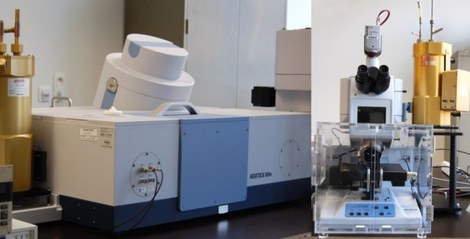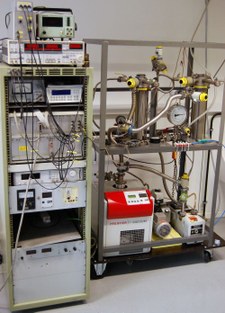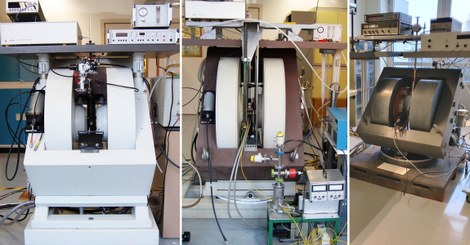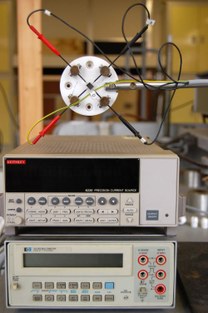Facilities
Fourier Transform Infrared spectroscopy (FT-IR)
This facility was realized through a Hercules-1 project: FT-IMAGER, a wide-range multi-purpose Fourier-Transform Infrared facility for Materials, Archaeological and GEological Research. Information on the consortium behind this project and recent research results can be found on this site.
Basic instruments
- BRUKER Vertex 80v vacuum wide-range multi-purpose FT-IR spectrometer, with spectral range between 15000 and 10 cm-1 (near- to far-IR)
- Hyperion 2000 microscope in the near, mid and far IR
Peripheral equipment
- Liquid helium cryostats for mid and far IR region: contact gas and cold finger
- Home-built vacuum sample compartment for photoluminescence extension
Measurement modes
- Transmission – Specular Reflection - Attenuated total reflection (ATR)
- Photothermal ionization spectroscopy (PTIS)
- Photoluminescence
Recent publications
-
Attenuated total reflection (ATR) micro-Fourier transform infrared (micro-FT-IR) spectroscopy to enhance repeatability and reproducibility of spectra derived from single specimen organic-walled dinoflagellate cystsPjotr Meyvisch, Pieter Gurdebeke, Henk Vrielinck, Kenneth Neil Mertens, Gerard Versteegh and Stephen Louwye
(2022) APPLIED SPECTROSCOPY. 76(2). p.235-254 - The path towards efficient wide band gap thin-film kesterite solar cells with transparent back contact for viable tandem application
Samira Khelifi, Guy Brammertz, Léo Choubrac, Maria Batuk, Sheng Yang, Marc Meuris, Nicolas Barreau, Joke Hadermann, Henk Vrielinck, Dirk Poelman, et al.
(2021) SOLAR ENERGY MATERIALS AND SOLAR CELLS. 219. - The biological plastic pump : evidence from a local case study using blue mussel and infaunal benthic communities
Carl Van Colen, Lieke Moereels, Brecht Vanhove, Henk Vrielinck and Tom Moens
(2021) ENVIRONMENTAL POLLUTION. 274.
Deep level transient spectroscopy (DLTS)
The following services with different measurement modes are possible for deep level transient spectroscopy.
Basic instruments
- PhysTech Fourier Transform DLTS equipped with liquid He/liquid N2 crystats (4-600 K) and Leybold temperature controller
- Agilent fast pulse generator (pulse length >1 ns) for fast electrical filling pulses
- Laser diodes (900 nm and 1500 nm) for optical filling pulses
Measurement modes
- DLTS: classical capacitance DLTS using electrical pulse (voltage range +/-100 V)
- CC-DLTS: constant capacitance DLTS
- ODLTS: capacitance DLTS using optical pulse
- CDLTS: current DLTS using optical or electrical pulse
- QDLTS: charge DLTS
Topics with selected papers
-
Analysis of semi-insulating carbon-doped GaN layers using deep-level transient spectroscopy
H.Y. Wang, P.C. Hsu, M. Zhao, E. Simoen, S. De Gendt, A. Sibaja-Hernandez, J.Y. Wang
(2021) J. Appl. Phys. 130 (20) Article No. 205701. -
Impact of band to band tunnelling in In0.53Ga0.47As tunnel diodes on the deep level transient spectra
S. Gupta, Eddy Simoen, R. Loo, Q. Smets, A. S. Verhulst, Johan Lauwaert, Henk Vrielinck, M. Heyns
(2018) APPLIED PHYSICS LETTERS 113 (23), Article No. 232101. -
Electrical properties of extended defects in strain relaxed GeSn
S. Gupta, Eddy Simoen, R. Loo, Y. Shimura, C. Porret, F. Gencarelli, K. Paredis, H. Bender, Johan Lauwaert, Henk Vrielinck, M. Heyns
(2018) APPLIED PHYSICS LETTERS 113 (2), Article No. 022102.
Electron Paramagnetic Resonance (EPR)
Spectroscopy at microwave frequencies is complicated by the narrow bandwidth of microwave components. Moreover, in EPR resonance cavities are used as microwave amplified, fixing the measurement frequency for every specific sample. In EPR spectroscopy this difficulty is easily overcome, since the separation of energy levels can be changed conveniently by varying the strength of an externally applied magnetic field. For this reason electron magnetic resonance experiments are typically performed at a single microwave frequency, and a spectrum is recorded as magnetic field sweeps. The spectrometers in our lab use a single microwave frequency of 9.5 GHz (X-band) and 34.0 GHz (Q-band).
The possibility to record spectra at different microwave frequencies is a great asset in EPR spectroscopy. Sometimes, having spectra at several microwave frequencies is even indispensable for unambiguous spectrum interpretation. It allows to separate field-dependent (e.g. electron and nuclear Zeeman interaction) from field-independent interactions (hyperfine, zero-field splitting) in the spin-Hamiltonian of detected paramagnetic centers. High-spin centers with large zero-field splitting may even require high-frequency EPR (≥ 94 GHz) and large magnetic fields (several Tesla) for detection of the EPR-allowed transitions. On the other hand, high-frequency EPR requires superconducting magnets and is difficult to operate (small microwave components, samples and sample holders). The intermediate Q-band frequency presents a nice compromise, combining the ease of operation of standard EPR (at X-band) with an already improved sensitivity and g-factor resolution, and increased detectabilty for centers with large zero-field splitting (compared to X-band).
In favor of the highest frequency, there is increased sensitivity, minimization of higher order effects, improved resolution, and spectroscopy between levels whose zero field splitting is of the order of the microwave quantum.
- Q-band EPR/ENDOR (Bruker Elexsys E500)
The frequency range is 33.8 GHz - 34.1 GHz. Microwave power: 160 mW and maximum magnetic field value: 1.5 T.
Temp range 3 - 300 K
In situ illumination possible - X-band EPR/ENDOR (Bruker ESP300E)
The frequency range is 9.5 GHz - 9.8 GHz. Microwave power: 200 mW and maximum magnetic field value: 1.0 T.
Temp range 3 - 300 K (regular cavity) and 300 - 1273 K (cylindrical cavity)
In situ illumination possible - X-band EPR (Varian E-line)
The frequency range is 8.87 GHz - 9.65 GHz. Microwave power: 200 mW and maximum magnetic field value: 0.9T
Temp range 3 - 300 K
Dual cavity
Left picture: Q-band setup, middle: X-band EPR/ENDOR, right picture: X-band EPR
Topics with selected papers
- Realizing simultaneous X-ray Imaging and dosimetry using phosphor-based detectors with high memory stability and convenient readout process
Zetian Yang , Jieqi Hu , David Van der Heggen , Ang Feng , Hairong Hu , Henk Vrielinck , Philippe Smet, Dirk Poelman
(2022) ADVANCED FUNCTIONAL MATERIALS. 32(31). - Identification of vanadium dopant sites in the metal-organic framework DUT-5(Al)
Kwinten Maes, Lisa Martin, Samira Khelifi , Alexander Hoffman, Karen Leus, Pascal Van Der Voort, Etienne Goovaerts, Philippe Smet, Veronique Van Speybroeck, Freddy Callens, Henk Vrielinck
(2021) PHYSICAL CHEMISTRY CHEMICAL PHYSICS. 23(12). p.7088-7100 - Metal-free activation of molecular oxygen by covalent triazine frameworks for selective aerobic oxidation
Sara Abednatanzi , Parviz Gohari Derakhshandeh , Karen Leus , Henk Vrielinck , Freddy Callens , Johannes Schmidt, Aleksandr Savateev, Pascal Van Der Voort
(2020) SCIENCE ADVANCES. 6(14).
Other electrical characterisation
Hall - Van der Pauw setup
The Van der Pauw method makes it possible to precisely determine the electrical resistivity of a material by means of 4 contact points. Two contact points apply a well known current to the material, the other two measure the voltage across the material. This technique has the advantage to cancel out contact resistance on the measurement result. The same setup could also be used to measure Hall voltage.
Minority carrier lifetime measurement
The lifetime of minority charge carriers can be measured using contact and non-contact methods.
All requests for DLTS, FTIR and EMR measurements may be addressed directly to DiSC@UGent.be and will be evaluated on an individual basis.



